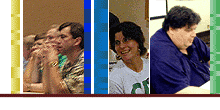|












 |
|
|
|
September 29th - September 30th, 2005
Rockville, MD
Topics
This year's topics are divided into three tracks Beginner, Advanced, and Other. Print a copy of the schedule. |
Advanced
Using Fusebox with CFCs: An OO Approach
Hal Helms
Read Interview
|
In this class, Hal explains how Fusebox works very well as the controller in a Model-View-Controller architecture, calling on Model components done in either CFCs or Java.
|
Leveraging the Fusebox 4 XML Vocabularies
Jeff Peters
Read Interview
|
Want to learn best practices for using the Fusebox 4 XML vocabularies for application and circuit configuration? Wish that you had powerful XSLT tools to manipulate the XML? Check out this session to learn more.
|
Migrating Applications Between Frameworks
Joe Rinehart
|
I'd like to see a series of presentations on migrating applications to different frameworks. Like FB3 --> FB 4 FB4 --> Mach-ii FB4 --> Model-Glue Mach-ii --> Model-Glue Not only would it prove practical to most developers, the presentations should serve as a good comparison between the frameworks. Personally, since this is more of a framework conference now, I would _love_ to see some frameworks for Flex and RIA. Multiple framework integration would be cool too. Like using mach-ii or model-glue to service an AJAX or Flex application in an service oriented architecture.
|
Taming Framework XML files with XSLT and XDoclet
John Paul Ashenfelter
Read Interview
|
One common feature of the various ColdFusion application frameworks is the use of XML in the configuration and deployment files. This session covers ways to harness XSLT tools and the open source XDoclet project to simply the creation, maintenance, and deployment of the XML documents that make Fusebox, MachII, and the other frameworks work. These robust, mature tools have been heavily used in the Java world to simplify code development, promote continuous-integration, and enable Agile development teams. You'll leave with working examples that can be used to jumpstart your own development processes.
|
Layouts in Fusebox 4
Sandy Clark
Read Interview
|
Layouts in Fusebox 4 offer the developer the ultimate in flexibility. Rather than just one way to do a layout, Fusebox 4 allows us to design our layouts in a variety of different ways, making sure the layout is suited to the particular application. In this session, we will be exploring using layouts at the application, circuit and fuseaction level. We will also learn how to use the newest part of layouts, content variables to stream content into the layout of our choice. Also covered in this session will be how to emulate nested layouts for those considering converting legacy applications.
|
Lock/key security plugin
Sandy Clark
Read Interview
|
One of the most requested features in Fusebox has been a security plugin and Sandra Clark has written one. Based on a lock/key approach, the plugin and accompanying function allow you to apply security to the circuit or fuseaction level as well as applying specific security to more granular items such as navigation, links or buttons. This plugin will be released to the Fusebox community at the Fusebox Conference.
|
Best Practices and Frameworks
Simon Horwith
|
In this session, Simon describes the techniques he has found most useful in developing applications without implementing any "traditional" framework or methodology. His development technique, self-described as an "API-based" approach todevelopment, implements several common design patterns and enforces best practices.
|
Creating Your Own XML Verbs in Fusebox
John Quarto-vonTivadar
|
Do you wish Fusebox's circuit.xml files were more flexible? Do you have a need to add or alter the behavior of one of the XML verbs? John Quarto-vonTivadar explains how the new lexicon feature in Fusebox 4.2 will let you do just that.
|

Basic
Building your first FB application
Jeff Peters
Read Interview
|
Jeff Peters will give a hands on rapid introduction to the mechanics of Fusebox 4. In this session you will build a fully functional application with Jeff's help. Bring your own laptop with ColdFusion already installed on it. The class files will be made available for download before the session. If there is time left following the build, the floor will be open for further Fusebox discussion.
|
Introduction to Fusebox
Simon Horwith
|
This session will compare an application written without a framework to the same application written in Fusebox 4.1
|
Optimizing Architectures for Search Engines
Jon Rowny
Read Interview
|
Students will learn how search engines work and what they can do to get better search engine placement for their sites.
|
Strategies for Successful Development with FLiP
Maxim Porges
|
Your client is relying on you to build them the perfect solution, and they want it yesterday! You promise to meet expectations by delivering a working, maintainable application on time and on budget, while maximizing the productivity of your team. But doing things right the first time is hard. Clients can't make up their minds, developers and project managers don't always understand each other, and scope creep pushes your timelines and your development costs off the charts. The good news is, there is a perfect solution - and it's easy! It's called FLiP (the Fusebox Lifecycle Process), and you don't need to code with Fusebox to reap its benefits. In this session, Maxim will take you through every step of FLiP. You'll learn how it will help your team and your clients move through a lifecycle that delivers maximum productivity and perfect solutions every time. You'll leave the session with tips, best practices, and a turnkey solution for using FLiP successfully on your next project.
|
Using FLiP to streamline your distributed development business model Workshop
Michael Smith
|
FLiP is the Fusebox Lifecycle Process of Wireframing, Prototyping and Signoff. What problems have you had using FLiP in your organization? Did your boss or client avoid the process? How can resistance to FLiP be overcome? How can you sell the process to your clients? This workshop will address these problems that are common to many Fuseboxers in the Real World including: "From Developers to Architects" Evangelising the client on FLiP. Discussion of FLiP "phases" in relation to the small business sales-cycle. How to get paid for the engineering work done before a project has been fully defined and proposed. Creating an appropriate seperation of duties in the FLiP process. Who should do what? Using FLiP in a distributed development environment. Refining communications and development practices between you and your external development team. Gen. managing projects.
|
This Glue Dries Fast
Joe Rinehart
|
The Model-Glue framework has burst onto the ColdFusion framework scene. Come see a rapid-fire introduction to the framework, its concepts, and the construction of a simple application.
|
Fusedocs for Better Code
Hal Helms
Read Interview
|
Fusedocs are at the foundation of a sucessful Fusebox project. Written in an XML format they can be cryptic to beginners but this talk will explain all the tags in Fusedocs and show you tools to make writing them easier. We will also look at tools that use the XML data to improve your code.
|

Keynote
The Psychology of Frameworks
Jeff Peters
|
Opening Keynote -Speaking with Jeff Peters
|
The Psychology of Frameworks
Hal Helms
|
Opening Keynote - Speaking with Jeff Peters
|

Other
Managing Your Career as a Developer
Scott Knaub
Read Interview
|
What to think about as your career matures. Do you go into management or focus on a development specialty? Do you build the next killer app and run a business around it?
|
Mach-II Architecture: Under the Hood
Ben Edwards
Read Interview
|
Mach-II is an application framework that implements an event-based, implicit invocation architecture. The framework’s job is to handle requests, package request information into events, and process the events in a controlled and consistent manner. This talk will take us under the hood of Mach-II. We'll learn about Mach-II's architecture, how it does its job, and how we extend the framework and build on top of it to produce reusable software and powerful applications.
|
Power onTap
Isaac Dealey
Read Interview
|
An introduction to the onTap framework including basic application, file and directory structure, modular presentation with xhtml, form-management, sql abstraction and a demonstration of how to create a basic application in 15 minutes.
|
Ruby on Rails for CF Developers
John Paul Ashenfelter
Read Interview
|
One of the hottest frameworks in the web development world is Rails, written for and in the open source Ruby programming language. And while you can't build your ColdFusion application in Rails (yet!), there's still a lot that can be learned from the framework and the Rails approach to application architecture. Come learn about the framework that's having Java, PHP, and even .NET developers thinking about running Ruby on Rails for their next application.
|
TheHUB - A ColdFusion Application Framework
Neil Ross
Read Interview
|
TheHUB is an easy to learn and simple to implement ColdFusion application development framework. TheHUB consists of only a few core files and a methodology for building and extending applications. TheHUB is a 'smart' framework and does not require maintenance of a configuration file as you extend your application. In this session, I'll discuss the core of TheHUB and show you how easy it is to build and extend small to enterprise-level ColdFusion applications using TheHUB.
|
Tartan Framework and Service Architectures
Paul Kenney
|
This is just a rough cut: Introduction to the Tartan Framework and using service architectures to build solid domain models in isolation from the rest of your application layers. Will show how Tartan can make your model instantly available to any of the existing MVC frameworks as well as remote clients using webservices and Flash remoting.
|
Head First Mach-II
Matthew Woodward
|
Are you new to Mach-II, or have you tried to use Mach-II before but needed more guidance to get started? If so, this session is for you! "Head First Mach-II" will give those with little to no Mach-II experience the foundation they need to better understand the concepts behind the framework and start building Mach-II applications. All questions will be answered and all Mach-II truths revealed in this fun, interactive session about the powerful and popular Mach-II framework.
|
Easy Java/J2EE with ColdFusion and the Spring Framework
Maxim Porges
|
Have you ever wanted to add "J2EE" to your resume, but found Java daunting? Or maybe you've needed to use a Java library (like Hibernate) in ColdFusion, but didn't know where to start? Or perhaps you wanted to write a platform-independent API you could use outside of ColdFusion as well as within it? If you answered yes to any of these questions, then this topic is for you. The world has become object oriented. While ColdFusion has CFCs, J2EE is the big kid on the block. ColdFusion brings powerful capabilities to J2EE, but many CF developers are unsure of how to bring their existing skills to the Java/J2EE world. In this session, you will be introduced to the Spring Framework: a simple and powerful way to make building applications with Java and ColdFusion as easy as using CFCs. You'll learn how to apply your existing skills to leverage capabilities that CFCs don't have (like Aspect-Oriented Programming). Finally, you'll see how Java and Spring work in perfect harmony with Fusebox and all the other ColdFusion frameworks. After this session, you'll be ready to use ColdFusion and Java to build your next killer application.
|

|
| HOME
| DIRECTIONS
| HOTEL |
| TOPICS
| SPEAKERS
| REGISTER
| CF CONF CENTRAL |
|



